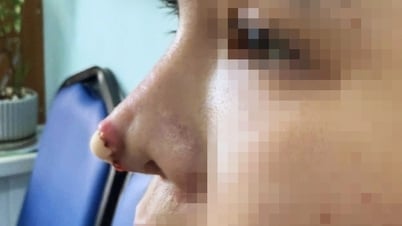According to the Food Safety Department ( Ministry of Health ), botulinum toxin poisoning is severe poisoning, with a high risk of death or long-term effects on health. This is a toxin produced by the bacteria Clostridium botulinum in an anaerobic environment (an environment lacking air).
Previously, in some localities such as Kon Tum province, Binh Duong province, Hanoi ... there were some cases of patients poisoned by botulinum toxin. Patients poisoned by botulinum showed symptoms of nausea, vomiting, bloating, abdominal pain, paralysis in the order of paralysis starting from the head, face and neck, spreading down to both arms, then to both legs, paralysis of respiratory muscles; severe paralysis can cause respiratory failure which is the cause of death.

Image of Clostridium botulinum bacteria
Dr. Nguyen Trung Nguyen, Director of the Poison Control Center, Bach Mai Hospital, said that food poisoning caused by botulinum toxin usually only occurs with sealed foods in an airless environment (in boxes, bottles, jars, cans, cans, bags, and pouches) while the production conditions are contaminated and the environment inside the food is not guaranteed.
Botulinum is an extremely toxic substance. This toxin can cause death in doses of less than 0.1 mg, and can be considered one of the most toxic toxins today. It is worth noting that food poisoning caused by botulinum toxin does not occur often in reality, and epidemiological factors and typical manifestations of the disease are often difficult to exploit, making definitive diagnosis very difficult.
However, the most common "culprit" can be identified as botulism bacteria (because it initially occurred mainly with canned meat). This bacteria exists widely in the environment and can be mixed in many types of food ingredients, at this time the bacteria are in a shelled form that can withstand normal cooking (called spores).

Cho Ray Hospital doctors examine a patient with botulinum poisoning in Quang Nam
"Foods that are processed contain some bacterial spores (the production process is not clean). After production, the food is packaged tightly in bottles, jars, boxes, cans, and bags, while the acidity and saltiness are not sufficient as above, which clearly creates conditions for bacteria to grow and secrete botulinum toxin," said Dr. Nguyen.
In addition, foods at risk can include fermented or canned vegetables, fruits, meat, seafood, etc. that do not meet food safety conditions and are at risk of being contaminated with Clostridium botulinum bacteria and producing botulinum toxin.
According to Dr. Nguyen, although botulinum is an extremely strong neurotoxin, it will be quickly destroyed when cooked. If this toxin is absorbed into the body, it will attach to the nerves, causing paralysis of all muscles.
After eating, usually about 12-36 hours (can be up to 1 week after eating), the patient shows paralysis in a sequence starting from the head, face, and neck area (difficulty swallowing, sore throat, difficulty speaking, hoarseness, unable to open eyes, spreading down to the arms (weak arms), then to the legs (weak legs), paralysis of the respiratory muscles (wheezing, phlegs in the throat, difficulty breathing).
The characteristic features of paralysis are flaccid paralysis, bilateral symmetrical paralysis, spreading down from the head to the feet. Notably, the patient has no sensory disturbances and remains conscious (because the toxin does not affect the brain). Gastrointestinal symptoms may include nausea, vomiting, abdominal pain, and decreased intestinal motility. Severe paralysis can cause respiratory failure, which is the cause of death.

Medical experts recommend not using canned products that are swollen or deformed.
In cases of complete paralysis, many patients have dilated pupils similar to deep coma, brain loss although still conscious and aware of their surroundings (with the condition of emergency care, respiratory resuscitation and no brain hypoxia).
Mild cases may only have muscle weakness, similar to asthenia, unable to perform strenuous movements. The paralysis lasts a long time, the average time on a ventilator in patients is 2 months, it can be longer and require many months to recover.
To prevent food poisoning caused by botulinum toxin, the Food Safety Department recommends using only food products and food ingredients with clear origin and source, and absolutely do not use canned products that have expired, are swollen, flattened, deformed, rusted, are no longer intact, or have unusual flavors or colors...
In recent days, the Northern Mountainous Region General Hospital of Quang Nam has received many cases of botulinum poisoning after eating pickled carp. These cases are all in Phuoc Son district, Quang Nam.
Test results confirmed that the pickled carp sample was positive for Clostridium botulinum type E bacteria. The Ministry of Health has requested to focus resources on treating patients with pickled carp poisoning in Quang Nam.
Source



![[Photo] Top players gather at the 2025 Nhan Dan Newspaper National Table Tennis Championship](https://vphoto.vietnam.vn/thumb/1200x675/vietnam/resource/IMAGE/2025/5/23/9ad5f6f4faf146b08335e5c446edb107)



























































































Comment (0)